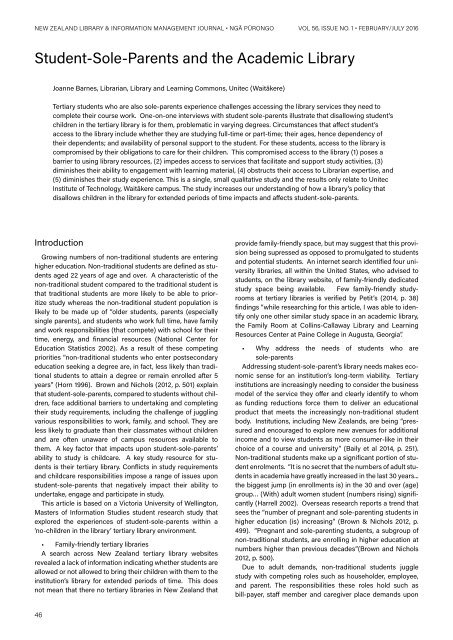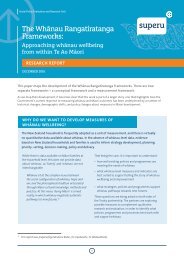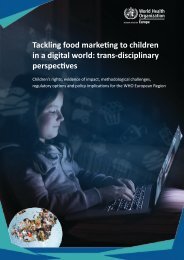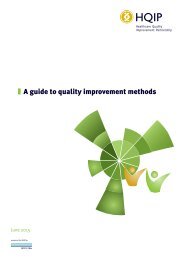THE NEW ZEALAND LIBRARY & INFORMATION MANAGEMENT JOURNAL NGĀ PŪRONGO
NZLIMJ%20FebJuly%202016
NZLIMJ%20FebJuly%202016
You also want an ePaper? Increase the reach of your titles
YUMPU automatically turns print PDFs into web optimized ePapers that Google loves.
<strong>NEW</strong> <strong>ZEALAND</strong> <strong>LIBRARY</strong> & <strong>INFORMATION</strong> <strong>MANAGEMENT</strong> <strong>JOURNAL</strong> • <strong>NGĀ</strong> <strong>PŪRONGO</strong> VOL 56, ISSUE NO. 1 • FEBRUARY/JULY 2016 <strong>NEW</strong> <strong>ZEALAND</strong> <strong>LIBRARY</strong> & <strong>INFORMATION</strong> <strong>MANAGEMENT</strong> <strong>JOURNAL</strong> • <strong>NGĀ</strong> <strong>PŪRONGO</strong> VOL 56, ISSUE NO. 1 • FEBRUARY/JULY 2016<br />
Student-Sole-Parents and the Academic Library<br />
Joanne Barnes, Librarian, Library and Learning Commons, Unitec (Waitākere)<br />
Tertiary students who are also sole-parents experience challenges accessing the library services they need to<br />
complete their course work. One-on-one interviews with student sole-parents illustrate that disallowing student’s<br />
children in the tertiary library is for them, problematic in varying degrees. Circumstances that affect student’s<br />
access to the library include whether they are studying full-time or part-time; their ages, hence dependency of<br />
their dependents; and availability of personal support to the student. For these students, access to the library is<br />
compromised by their obligations to care for their children. This compromised access to the library (1) poses a<br />
barrier to using library resources, (2) impedes access to services that facilitate and support study activities, (3)<br />
diminishes their ability to engagement with learning material, (4) obstructs their access to Librarian expertise, and<br />
(5) diminishes their study experience. This is a single, small qualitative study and the results only relate to Unitec<br />
Institute of Technology, Waitākere campus. The study increases our understanding of how a library’s policy that<br />
disallows children in the library for extended periods of time impacts and affects student-sole-parents.<br />
Introduction<br />
Growing numbers of non-traditional students are entering<br />
higher education. Non-traditional students are defined as students<br />
aged 22 years of age and over. A characteristic of the<br />
non-traditional student compared to the traditional student is<br />
that traditional students are more likely to be able to prioritize<br />
study whereas the non-traditional student population is<br />
likely to be made up of “older students, parents (especially<br />
single parents), and students who work full time, have family<br />
and work responsibilities (that compete) with school for their<br />
time, energy, and financial resources (National Center for<br />
Education Statistics 2002). As a result of these competing<br />
priorities “non-traditional students who enter postsecondary<br />
education seeking a degree are, in fact, less likely than traditional<br />
students to attain a degree or remain enrolled after 5<br />
years” (Horn 1996). Brown and Nichols (2012, p. 501) explain<br />
that student-sole-parents, compared to students without children,<br />
face additional barriers to undertaking and completing<br />
their study requirements, including the challenge of juggling<br />
various responsibilities to work, family, and school. They are<br />
less likely to graduate than their classmates without children<br />
and are often unaware of campus resources available to<br />
them. A key factor that impacts upon student-sole-parents’<br />
ability to study is childcare. A key study resource for students<br />
is their tertiary library. Conflicts in study requirements<br />
and childcare responsibilities impose a range of issues upon<br />
student-sole-parents that negatively impact their ability to<br />
undertake, engage and participate in study.<br />
This article is based on a Victoria University of Wellington,<br />
Masters of Information Studies student research study that<br />
explored the experiences of student-sole-parents within a<br />
‘no-children in the library’ tertiary library environment.<br />
• Family-friendly tertiary libraries<br />
A search across New Zealand tertiary library websites<br />
revealed a lack of information indicating whether students are<br />
allowed or not allowed to bring their children with them to the<br />
institution’s library for extended periods of time. This does<br />
not mean that there no tertiary libraries in New Zealand that<br />
provide family-friendly space, but may suggest that this provision<br />
being supressed as opposed to promulgated to students<br />
and potential students. An internet search identified four university<br />
libraries, all within the United States, who advised to<br />
students, on the library website, of family-friendly dedicated<br />
study space being available. Few family-friendly studyrooms<br />
at tertiary libraries is verified by Petit’s (2014, p. 38)<br />
findings “while researching for this article, I was able to identify<br />
only one other similar study space in an academic library,<br />
the Family Room at Collins-Callaway Library and Learning<br />
Resources Center at Paine College in Augusta, Georgia”.<br />
• Why address the needs of students who are<br />
sole-parents<br />
Addressing student-sole-parent’s library needs makes economic<br />
sense for an institution’s long-term viability. Tertiary<br />
institutions are increasingly needing to consider the business<br />
model of the service they offer and clearly identify to whom<br />
as funding reductions force them to deliver an educational<br />
product that meets the increasingly non-traditional student<br />
body. Institutions, including New Zealands, are being “pressured<br />
and encouraged to explore new avenues for additional<br />
income and to view students as more consumer-like in their<br />
choice of a course and university” (Baily et al 2014, p. 251).<br />
Non-traditional students make up a significant portion of student<br />
enrolments. “It is no secret that the numbers of adult students<br />
in academia have greatly increased in the last 30 years...<br />
the biggest jump (in enrollments is) in the 30 and over (age)<br />
group… (With) adult women student (numbers rising) significantly<br />
(Harrell 2002). Overseas research reports a trend that<br />
sees the “number of pregnant and sole-parenting students in<br />
higher education (is) increasing” (Brown & Nichols 2012, p.<br />
499). “Pregnant and sole-parenting students, a subgroup of<br />
non-traditional students, are enrolling in higher education at<br />
numbers higher than previous decades”(Brown and Nichols<br />
2012, p. 500).<br />
Due to adult demands, non-traditional students juggle<br />
study with competing roles such as householder, employee,<br />
and parent. The responsibilities these roles hold such as<br />
bill-payer, staff member and caregiver place demands upon<br />
their time, energy and resources that mean that they “have<br />
special needs and situations that require responsive programming.<br />
Most of them share some common characteristics. The<br />
majority… are female; they have children at home; they are<br />
full-time students; and they work full-time. All of these factors<br />
contribute to a high level of stress and anxiety” (Harrell 2002).<br />
Watson 2007). Adult female students have many of the same<br />
motivations, barriers and stresses as adult male students.<br />
“The stress factors do not seem to be related to gender, but<br />
rather to which roles the student has outside of the classroom.<br />
A male student with children who does not have a spouse<br />
assisting with child care or other home responsibilities will<br />
be just as anxious and stressed as his female counterparts”<br />
(Harrell 2002).<br />
Research confirms the student-sole-parent population<br />
experience added pressure and stress, especially related to<br />
childcare needs while pursuing education. “Few resources<br />
exist for these students and the universities who provide services<br />
do not adequately promulgate them to the campus community”<br />
(Brown and Nichols 2012, p. 499). Other issues cited<br />
by student-sole-parents as being prohibitive to engaging in<br />
study include the lack of sole-parent facilities on campus<br />
(Springer et al 2009, p. 435 - 454) and childcare difficulties<br />
(Matus-Grossman & Gooden, 2001, p. 19; Duquaine-Watson<br />
2007, p.229-240). As Harrell (2002) explains, these factors need<br />
to be considered when designing library services for students<br />
in order to provide for responsive individualized and in-person<br />
services. Despite the increase in sole-parent enrolments, their<br />
needs are not being adequately addressed through policy<br />
development and resource allocation to enable this population<br />
to be successful in their study program. Educational institutions<br />
need to update their policy and resourcing allocations<br />
to better meet the learning needs of sole-parents in order to<br />
attract and retain this growing population.<br />
• How student-sole-parents are faring<br />
Literature documents the sole-parents experience of<br />
tertiary education as one of isolation, marginalisation, stigmatisation<br />
and inconvenience while being characterised by<br />
feelings of inadequacy and not fitting in. Duquaine-Watson<br />
2007 (p. 234); Yakaboski 2010 (p. 465) conducted studies into<br />
mothers as students and reported they were experiencing a<br />
sense of being stigmatized by the larger, traditional, campus<br />
population, which resulted in them having feelings of isolation<br />
and disconnection from their peers and learning community.<br />
It was also found that some student-sole-parents created<br />
resilience through forming learning communities with other<br />
mothers. “This self-identifying sometimes created camaraderie<br />
with other student-sole-parents, some found that this<br />
led to marginalization in the classroom or stereotyping of the<br />
experience. This stereotyping included the ideas that most<br />
single mothers are welfare recipients and single mothers are<br />
rewarded or receive a free ride through federal assistance<br />
programs” (Brown and Nichols 2012, p. 501).<br />
Although a sense of camaraderie with other student-sole-parents<br />
provides some sense of inclusion within<br />
a supportive peer group, this inclusion can cost the studentsole-parent<br />
the more desirable, more appropriate status of<br />
‘student’ as they are often instead defined, by peer students<br />
who are traditional student peers, by their sole-parenting role<br />
rather than by their role as a student (Duquaine-Watson 2007,<br />
p. 234). Duquaine-Watson (2007, p. 234) also reported that<br />
many student-sole-parents became keenly aware of how limited<br />
their interactions with other students became once they<br />
became aware of their role as a sole-parent. The sole-parenting<br />
student’s role as sole-parent became the focus in<br />
conversation.<br />
• What academic libraries are doing?<br />
Within a literature review, the author could only identify four<br />
academic library family-friendly study spaces. One, Portland<br />
State University Library; (2), the Family Room at Collins-<br />
Callaway Library and Learning Resources Center at Paine<br />
College in Augusta, Georgia; (3) the Child-Friendly Group<br />
Study-Room at the University of California, San Diego Library<br />
and; (4) the Family Reading Room at the J. Willard Marriot<br />
Library, The University of Utah. As Petit verified within her<br />
2014 research study, family-friendly library space in tertiary<br />
libraries is rare (p. 38). As documented in her study, Portland<br />
State University (PSU) Library created a family-friendly study<br />
room for student-parents and their children at Portland<br />
State University Library in response to a student profile that<br />
included “large number of non-traditional students, many of<br />
whom have taken long breaks in their post-secondary education”<br />
(Petit 2014, p. 36). In 2010, PSU commissioned the<br />
Presidential Task Force on Child Development and Family<br />
Support. According to this 2011 report, “It was apparent from<br />
the interviews with sole-parents and data collected, that the<br />
need for more family-focused and family-friendly spaces<br />
and places on campus in a variety of locations is pressing.<br />
[This includes] space for children to play quietly while their<br />
sole-parents study or work …” (Balzer et al, 2011). The Collins-<br />
Callaway Library and Learning Resources Center at Paine<br />
College created family-friendly study space in response to<br />
a “growing population (of) students with families, including<br />
small children,” and they report increased traffic from this<br />
population with the establishment of the new space (McCoy,<br />
2013, p. 1).<br />
Research Questions<br />
• Primary questions<br />
To what extent does the ‘no-children-in-the-library’ tertiary<br />
library stance affect student-sole-parents’ ability to undertake<br />
their studies and engage in the student experience?<br />
• Sub-questions<br />
How does the ‘no-children-in-the-library’ policy impact student-sole-parents’<br />
short term study goals?<br />
How does the ‘no-children-in-the-library’ policy effect student-sole-parents’<br />
desire to study?<br />
Methods<br />
Statistics New Zealand Census provided quantitative<br />
data about one parent families in New Zealand over the last<br />
decade, and identified issues sole-parents experience when<br />
considering or attempting to study.<br />
To answer the above research questions, qualitative information<br />
was gained from in-depth face-to-face interviews<br />
with 6 students from Unitec Institute of Technology students<br />
46 47






